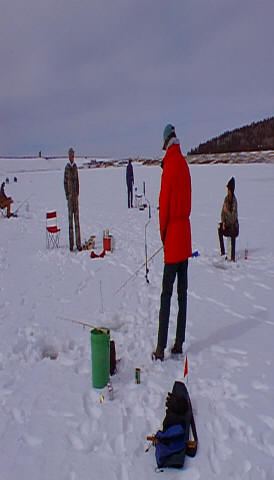Ice fishing has recently come into its own as a winter spo rt or
recreation activity, quickly gaining popularity around northern Arizona. To
accommodate those who choose to fish during the winter, many northern roads are
kept open all year, and some local merchants and resorts have extended their
business season to include prime ice fishing months. However, wether you are a
novice or a seasoned ice-fisher, before you grab your fishing gear and take to
the ice, there are some precautionary measures you should take to ensure you
are equipped for the dangers one might incur. rt or
recreation activity, quickly gaining popularity around northern Arizona. To
accommodate those who choose to fish during the winter, many northern roads are
kept open all year, and some local merchants and resorts have extended their
business season to include prime ice fishing months. However, wether you are a
novice or a seasoned ice-fisher, before you grab your fishing gear and take to
the ice, there are some precautionary measures you should take to ensure you
are equipped for the dangers one might incur.
BEFORE YOU GO:
Never go fishing alone (especially at lakes inaccessible to
traffic.) Make sure family and friends know your destination in case an
emergency occurs.
Wear protective clothing in fabrics which will continue to
protect, even when wet. Layering clothing to maintain a balanced body
temperature is best using a thermal layer close to the skin to absorb body
moisture, an insulating material for warmth (Polar/Artic fleece is a good one),
and a protective, water resistant layer on top.
Bring an extra set of clothing and keep it handy in case you do
get wet.
Carry a long pole to your fishing destination. It can be used to
test the thickness and soundness of the ice, and it can prevent you from
sinking if the ice does break.
CHOOSING A LOCATION:
The chart below gives a rough estimation of the amount of
pressure frozen ice can withstand at varying thicknesses.
2 inches-one person on foot
3 inches-group in single file
8 inches-automobile (1 ton gross)
10 inches-truck (2 tons gross)
36 inches-36 tons plus
The Arizona White Mountains houses a number of popular and
easily accessible Lakes for ice fishing. There are various factors to consider
when choosing a location to fish. Depending on the severity or mildness of the
season, some of the lakes in the lower elevations of the White Mountains may
not be suitable for fishing. Lower elevation areas such as Mogollon Rim and
Flagstaff-Williams lakes will only be safe if the conditions in the area have
been steadily cold.
LOWER ELEVATION LAKES (6,500 ft. to 7,500 ft.)
Show Low Lake
Rainbow Lake
Woodland Lake
Nelson Reservoir
HIGHER ELEVATION LAKES (7,500 ft. and above)
A-1 Lake
Big Lake (snow-mobile accessible only)
Sunrise Lake
Luna Lake
It is not uncommon for Arizona's winter nights to reach 0 degrees
accompanied by day temperatures in the 40s, 50s, and 60s. Temperature
fluctuation can produce effects in ice making its structural integrity
questionable. Ice which looks thick and solid may actually be riddled with
water pockets and soft spots. Checking the temperature of the area you plan to
fish daily will give you a good idea if the ice might be thawing, however your
fishing area should ALWAYS be proven safe.
When choosing a place to fish, there are a few things you need to
look out for before you cut. Slush ice is about half as strong as clear blue
ice, while new ice stronger than old ice. River ice is 15 percent weaker than
lake ice. As stated above, conditions are most hazardous when alternately
freezing and thawing occurs. Continuous travel over the same route will weaken
the ice. Remember to cut only small holes in the ice, preferably less than 10
inches in diameter. The holes should be large enough for a big fish, yet small
enough to ensure a person cannot fall into it.
Drowning is not the only potential hazard ice-fishers face.
Falling through ice at freezing/sub-freezing temperatures exposes the body to
evaporation, cold-air temperatures, and wind-chill factors which disturbs the
body's temperature, resulting in hypothermia. If you should get wet, change
into dry clothes as soon as possible and gradually warm your body.
Doing a little preliminary legwork and taking a few precautionary
measures can help make your hours of huddled anticipation safer and a bit more
comfortable.
For information on lake conditions, call the Apache-Sitgreaves
National Forest at 520-333-4301 or White Mountain Hunting & Fishing at
520-338-4385
This article written by Carrie J. Wheeler
|

